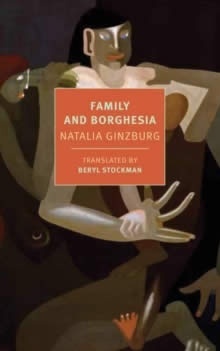Family and Borghesia

Editorial New York Review Of Books
Fecha de edición abril 2021 · Edición nº 1
Idioma inglés
EAN 9781681375083
120 páginas
Libro
encuadernado en tapa blanda
Dimensiones 127 mm x 203 mm
Resumen del libro
Two novellas about domestic life, isolation, and the passing of time by one of the finest Italian writers of the twentieth century.
Carmine, an architect, and Ida, a translator, lived together long ago and even had a child, but the child died, and their relationship fell apart, and Carmine married Ninetta, and their child is Dodo, who Carmine feels is a little dull, and these days Carmine is still spending every evening with Ida, but Ninetta has nothing to say about that. Family, the first of these two novellas from the 1970s, is an examination, at first comic, then progressively dark, about how time passes and life goes on and people circle around the opportunities they had missed, missing more as they do, until finally time is up.
Borghesia, about a widow who keeps acquiring and losing the Siamese cats she hopes will keep her company in her loneliness, explores similar ground, along with the confusions of feeling and domestic life that came with the loosening social strictures of the 1970s. She remembered saying that there were three things in life you should always refuse, thinks one of Natalia Ginzburg's characters, beginning to age out of youth: Hypocrisy, resignation, and unhappiness. But it was impossible to shield yourself from those three things. Life was full of them and there was no holding them back.
Biografía del autor
x{0026}lt;P Oriana Fallaci, que entrevistó a la autora, describió a x{0026}lt;B Natalia Ginzburg x{0026}lt;/B con estas palabras: Ni guapa ni elegante, con rebeca y falda de color azul ceniza, con ese aire un pelín apagado de tía soltera y sin edad definida ... . Pelo negro, pocas canas y un cuerpo compacto. Buenas piernas, de persona acostumbrada a caminar ... . Desde luego parece una mujer sana, hecha para llevar cargas y dolores con entereza. Sorprende su voz, como de x{0026}lt;I femme fatalex{0026}lt;/I . Es como si fuera la voz de otra, y te atrapa, te fascina . Esa mujer fue una de las voces más importantes de la literatura italiana del siglo XX. Nacida en Palermo en 1916, pronto se trasladó a Turín y más tarde, ya casada con Leone Ginzburg, vivió en Roma hasta que su marido fue asesinado en una cárcel de la capital por las fuerzas fascistas. Entre sus obras más conocidas, además de x{0026}lt;I Léxico familiarx{0026}lt;/I , que en 1963 fue galardonada con el Premio Strega, destacan x{0026}lt;I Las pequeñas virtudesx{0026}lt;/I ,x{0026}lt;I Querido Miguelx{0026}lt;/I ,x{0026}lt;I El camino que va a la ciudadx{0026}lt;/I ,x{0026}lt;I Familiasx{0026}lt;/I ,x{0026}lt;I Vida imaginariax{0026}lt;/I ,x{0026}lt;I La ciudad y la casax{0026}lt;/I ,x{0026}lt;I A propósito de las mujeresx{0026}lt;/I ,x{0026}lt;I Todos nuestros ayeres, Las palabras de la noche x{0026}lt;/I yx{0026}lt;I Las tareas de casa y otros ensayosx{0026}lt;/I . Ginzburg trabajó muchos años como redactora para la editorial Einaudi en su sede de Roma, ciudad donde residía cuando murió, en 1991.x{0026}lt;/P







